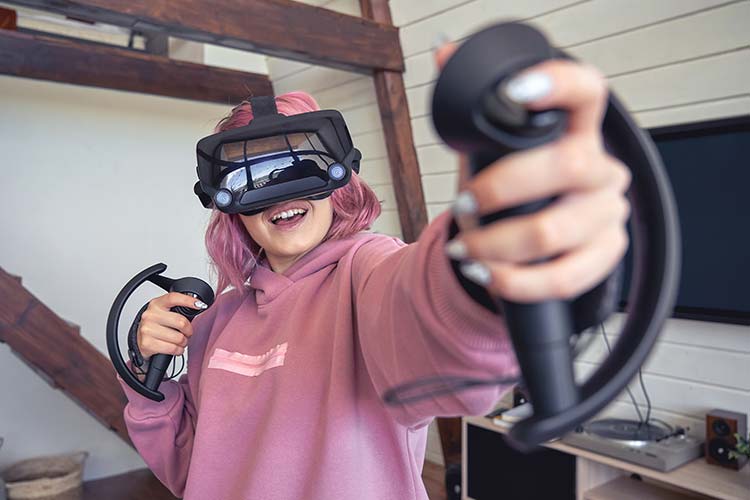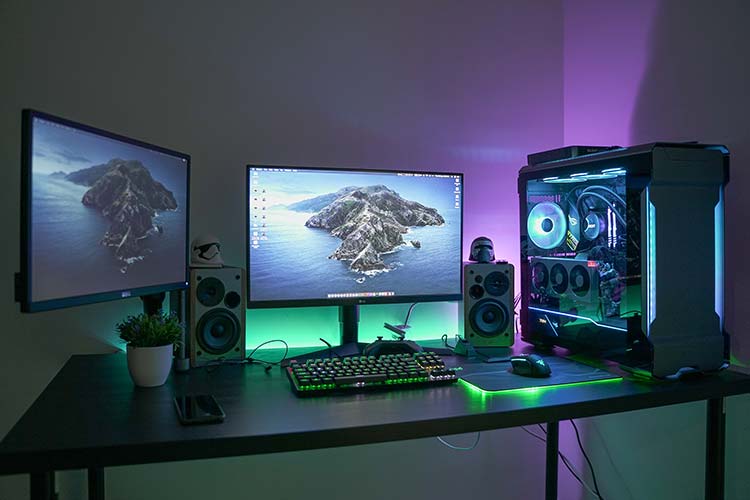While still relatively pricy to get into, VR is here to stay and offers an experience unmatched by any other form of entertainment available today. Better still it can be both educational and fun, and can be enjoyed by the entire family together. There are however a lot of ways to escape into a virtual world and here is what you need to know to have the best experience possible.
What is VR?
In simple terms virtual reality is a combination of software and hardware that together offer you a fully immersive 3D experience with a near 180 to 360-degree field of view. The content you consume through VR allows you to experience it as if you were present there yourself, allowing you get closer to what you are viewing than ever before.
What types of VR headsets are there?
There are effectively two categories of VR headsets – Standalone headsets such as the Oculus Quest, and PC headsets like the Oculus Rift and HTC Vive.
Standalone headsets, as the name implies, offer you everything you need for a full VR experience right out of the box. You won’t need any phones, consoles, or PCs to power it and you won’t need any wires either as they are, by their very nature, wireless. Another great advantage of standalone headsets such as the Oculus Quest 2 is the fact that, they also offer you the option of being able to connect to a PC and use them as a full-fledged PC-tethered headset.

PC Headsets are by a long way offer the most immersive VR experience. They however, require the highest investment. This is because not only are the headsets themselves significantly more expensive, they also require a powerful PC to power them. Furthermore, most PC headsets are tethered and will require some additional investment into optional hardware to make them operate wirelessly.
In addition to these there is also the console-tethered PlayStation VR and mobile headsets such as Samsung Gear VR and Google Daydream. The former behaves in much the same way as a PC-tethered headset, only using a PlayStation console to power it instead, while the latter type are effectively dead at this point. If they ever make a comeback, it will be in the form of tethered headsets that are currently being developed, which will connect to your phone via a USB Type-C connector.
Seated, Standing, or Room-scale?
Seated and standing are quite similar in that the user doesn’t need to move around. They can enjoy content designed to be used from a fixed location or by using various options or controls to simulate movement. Room-scale VR on the other hand requires you to set boundaries around a play area. While within this area, you are offered complete freedom to move around and interact with simulated objects in the game. Headsets that support room-scale utilise a so-called “guardian” or “chaperone” system to reveal the boundaries you set when you approach them to avoid any mishaps.

What Do You Need for a Full Room-scale Setup?
If you are really into VR, you will want the freedom to move around and have a full experience of Virtual Reality. The only way to experience this is to go for a Room-scale VR setup. For the more dedicated amongst you, the best solution would be to set up a VR Room, a permanent play space where you can freely interact with the immersive VR environment. These setups are also by far the most demanding and used specifically with standalone and PC headsets. Considering that the latter is the more complex of the two, we will focus on this setup primarily. So, here is what you will need to setup a dedicated home room-scale VR experience.
The Room
In general, most room-scale VR headsets require a minimum of 1m x 1m of space. This is however just an absolute minimum requirement. To have a decent room-scale VR experience we would recommend an open space of at least 2m x 2m. The larger you can go the better. Do keep in mind that, certain headsets like the HTC Vive utilise satellite sensors, called base stations, for tacking purposes. These have a max range that should not be exceeded to ensure optimal performance. In the case of the Vive, this range is 5m (equating to a square area of approximately 3.5m x 3.5m). Furthermore, if you are using a headset with base stations, they should be placed above head height, stable, pointed down 30-45 degrees, and have an unobstructed view of each other.
The Headset

Of all the PC headsets available right now, the Oculus Quest 2 is the most cost effective and versatile. As a standalone headset, you also don’t necessarily require a PC to get a VR experience but with the purchase of the appropriate cable from Oculus you can easily do so. It also features outward-facing tracking cameras on the headset itself for tracking purposes, so there is no need for base stations. Taking a step up from the Quest 2, you have a broad range of HTC headsets to choose from. These include their base Vive headset, modular Cosmos series with inside-out tracking, Cosmos Elite, or the Pro series which also features a model with eye-tracking technology. Alternatively, you also have the Valve Index with its high refresh rate screens. However, each of these headsets are, at the very least, double the price of the Oculus Quest 2 and all, with the exception of the base Cosmos, require base stations to function. They do however, offer a superior VR experience than the Quest and can even be made to operate wirelessly with the purchase of some additional accessories. Furthermore, Vive’s new base stations can also offer up to 100sq.m of tracking.
The PC
As mentioned earlier, a powerful PC is a must for a good VR experience. While the headset you have picked has a minimum hardware requirement that needs to be met, this is as the name implies, an absolute minimum requirement. As games and VR experiences get more advanced, so do the PC requirements. Therefore, we recommend getting the most powerful PC you can get your hands on, ensuring at the very least that it exceeds the requirements of the software/VR experience you wish to run on it. There are several “VR ready” systems available on the market or you could even take the plunge and custom build one based on the specs you need.

In conclusion, while VR as a whole is still a significant expense, it is certainly getting more affordable by the day. The Quest 2 is a clear testament to this fact. Furthermore, VR offers an unmatched visual experience that cannot be found elsewhere that is safe and fun for the entire family to enjoy together.

